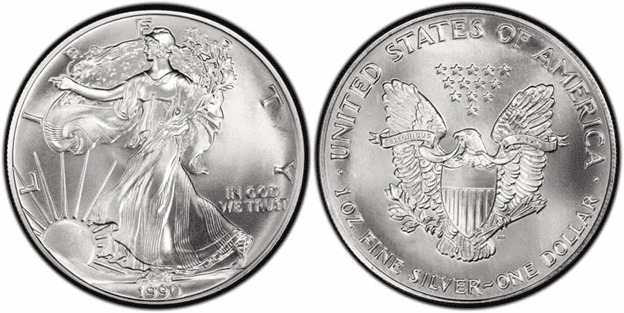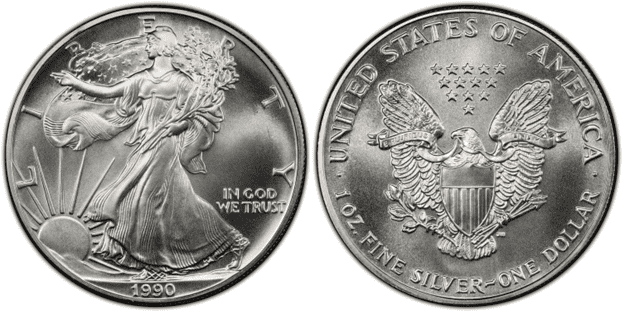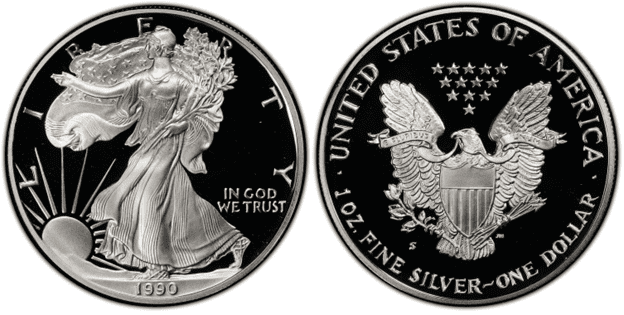What Is the 1990 Silver Dollar Made Of?
The 1990 silver dollar is made of 99.93% Silver and 0.007% Copper. It has a mass of 31.103 g, a diameter of 40.6 mm, a thickness of 2.98 mm, and a reeded edge. It was issued on November 24, 1986, up to the present.
The purity, content, and weight of this coin are all certified by the U.S. Mint. There are three mints where the 1990 silver dollar was made: West Point Mint, San Francisco Mint, and Philadelphia Mint.
According to most experts and most people would agree, the silver dollar has the most beautiful design among all coins produced by the U.S. Mint. Thus, this coin is popular among collectors.
The Walking Liberty obverse of the coin was designed by Adolph A. Weinman, who is a German-born American architectural sculptor. As you may remember, the Walking Liberty originally appeared in the half-dollar coin produced from 1916 to 1947.

The obverse includes the Walking Liberty, olive branches, sun, flag, and stars. Behind the Walking Liberty is the word “LIBERTY.” Just above his right ankle are the words, “IN GOD WE TRUST.” Beneath the Walking Liberty is the year of minting, which in this case, is 1990.
The reverse side of the coin features the heraldic eagle with its wings outspread and was designed by John Mercanti. The design looks similar to the Presidential Seal with a few modifications.
The eagle is the United States’ symbol of strength, power, and resiliency. The eagle holds on its beak a banner, which says, “E PLURIBUS UNUM.” This is the Latin for “Out of many, one.”
In front of the eagle is the shield with thirteen stripes that represent the 13 original states. On the left talon of the eagle, you’ll find a branch of olive, which signifies peace. On the right talon, you’ll find arrows, which symbolize readiness to go to war. Above the head of the eagle are 13 stars.
For the inscriptions, you’ll find the following:
- UNITED STATES OF AMERICA
- 10Z, FINE SILVER
- ONE DOLLAR
- Mint mark (if present)
- Designer’s initials
Recently, in 2021, the reverse was changed to a bald eagle landing on a branch. This was designed by Emily Damstra. The production of the silver dollar coin was made possible by the Title II of Public Law 99-61 (Liberty Coin Act).
1990 Silver Dollar Varieties
There are different types of the 1990 silver dollar coin. With each type, you’ll see some minor and major differences. Here are the 1990 silver dollar coins you might be interested in.
1990 Silver Eagle Dollar
Year of minting: 1990
Mint Mark: No mint mark
Place of minting: Philadelphia
Quantity produced: 5,840,210
Face Value: $1.00 (twenty-five cent)
Price: $11 to $600 dollars (or more)
Mass: 31.103 g
Edge: Reeded
Designer: Adolph Weinman (obverse) and John Mercanti (reverse)
Composition: 99.93% Silver and 0.007% Copper
Diameter: 40.6 mm
Thickness: 1.75 millimeters

The 1990 silver dollar was a standard struck coin made in the Philadelphia Mint. It has been a habit of the Philadelphia Mint not to add a mint mark. You can usually sell this 1990 silver dollar for $1 to $2, depending on the condition and rarity of your coin. At the end of 1990, there were more than 5.8 million silver dollar coins produced by the Philadelphia Mint.
1990 Silver Eagle Dollar
Year of minting: 1990
Mint Mark: S
Place of minting: San Francisco
Quantity produced: 695,510
Face Value: $1.00 (twenty-five cent)
Price: $47 to $700 dollars (or more)
Mass: 31.103 g
Edge: Reeded
Designer: Adolph Weinman (obverse) and John Mercanti (reverse)
Composition: 99.93% Silver and 0.007% Copper
Diameter: 40.6 mm
Thickness: 1.75 millimeters

The 1990 S silver dollar coin was struck in San Francisco. It has a nominal value of $1 but its worth can be as high as a few hundred and even thousands of dollars.
The San Francisco Mint is specialized in creating proof coinage. Thus, you can see here that the 1990-S silver eagle is proof. It is made with greater detail, a shinier backdrop, and more eye appeal.
Since proof coins are more difficult to produce, there were just almost 700,000 1990-S silver dollar proof coins produced.
List of 1990 Silver Dollar Errors
Compared to other types of coins, the 1990 silver dollar is significantly fewer. However, this doesn’t mean that its minting process was perfect.
Only a few silver dollar coins in 1990 were reported to have errors. Some errors happened due to misaligned dies, die breaks, clashed dies, rotated dies, mules, and others.
How Much Is the 1990 Silver Dollar Worth Today?
The American silver dollar eagle has a face value of one dollar. Its melt value is way higher since it is made of silver. The melt value of the silver dollar can go up and down, depending on the current value of silver per ounce.
Since the one-dollar silver coin is 1 ounce of silver and an ounce of silver is about $19.22, then you can say that the current melt value of your coin is $19.22.
Although the melt value of the silver coin is significantly higher than its face value, its worth is even higher when properly graded and assessed.
Here’s a table for you to compare the value of the silver dollar:
| Coin | Condition | Grade | Mintage | Value |
| 1990 Silver Eagle Dollar | Circulated/mint | Not graded | 5,840,210 | $1 to $20 |
| 1990 Silver Eagle Dollar | Uncirculated/mint | MS-68 | 5,840,210 | $26-$617 |
| 1990 Silver Eagle Dollar | Uncirculated/mint | MS-69 | 5,840,210 | $34-$2,880 |
| 1990 Silver Eagle Dollar | Uncirculated/mint | MS-70 | 5,840,210 | $1,200-$13,200 |
| 1990-S $1 Silver Eagle | Circulated/proof | Not graded | 695,510 | $1 to $20 |
| 1990-S $1 Silver Eagle | Uncirculated/proof | PR-68 | 695,510 | $46 to $764 |
| 1990-S $1 Silver Eagle | Uncirculated/proof | PR-69 | 695,510 | $47 to $94 |
| 1990-S $1 Silver Eagle | Uncirculated/proof | PR-70 | 695,510 | $144 to $288 |
As you can see, the 1990 silver dollar is truly valuable compared to other types of coins. So far, the most expensive 1990 silver dollar sold was during the Heritage Auction in June 2018. The silver coin was sold for $13,200.
How Does The Grading System Work?
The Sheldon Scale is used by numismatists to provide a numerical value to coins. The Sheldon Scale goes from poor (P-1) to perfect mint state (P-1) (MS-70). Coins were originally evaluated using words to reflect their condition (Good, Fair, Excellent, Etc.). Unfortunately, coin collectors and dealers had different ideas about what each of these terms represent.
Professional numismatists joined together in the 1970s and established CoinGrading standards. These numismatists now assign grades at key places on the seventy-point scale, using the most regularly utilized numeric points in conjunction with the original adjective grade. The following are the most common coin grades:
-
-
- (P-1) Poor – Indistinguishable and probably damaged; if used, must have a date and mintmark; otherwise, rather battered.
- (FR-2) Fair – Nearly smooth, but without the damage that a coin graded Poor often possesses. The coin must have enough detail to be identified.
- (G-4) Fair – Inscriptions have merged into the rims in some areas, and important elements have been mostly erased.
- (VG-8) Very Good- A little weathered, but all of the primary design elements are visible, albeit faintly. There is little if any, central detail left.
- (F-12) Good – The item is very worn, yet the wear is even, and the overall design details stand out clearly. Rims are almost completely isolated from the field.
- (VF-20) Very Fine – Moderately weathered, with some finer features still visible. The motto or all letters of LIBERTY are readable. Both sides of the coin have entire rims that are separated from the field.
- (EF-40) Extremely Fine – Gently used; all gadgets are visible, and the most important ones are bold. The finer details are bold and clear, however, light wear may be seen.
- (AU-50) Uncirculated – Slight evidence of wear on the coin’s design’s high points; may have contact marks; eye appeal should be adequate.
- (AU-58) Uncirculated Choice – Slight traces of wear, no severe contact marks, almost full mint shine, and great eye appeal.
- (MS-60) Mint State Basal – Strictly uncirculated; no indication of wear on the coin’s highest points, but an unsightly coin with reduced luster, visible contact marks, hairlines, and other flaws.
- (MS-63) Mint State Acceptable – Uncirculated, but with contact scratches and nicks, little reduced shine, but otherwise appealing appearance. The strike is weak to average.
- (MS-65) Mint State Choice – Uncirculated with great mint shine, very little contact blemishes, and exceptional eye appeal. The strike is unusually severe.
- (MS-68) Mint State Premium Quality – Uncirculated with superb luster, no obvious contact marks to the naked eye, and exceptional eye appeal. The strike is quick and appealing.
- (MS-69) Almost Perfect Mint State – Uncirculated with perfect brilliance, a sharp and appealing strike, and extremely good eye appeal. A near-perfect coin with minor imperfections in the planchet, strike, and contact markings (seen only under 8x magnification).
- (MS-70) Mint State Perfect – Under 8x magnification, there are no tiny imperfections discernible; the strike is crisp, and the coin is perfectly centered on a beautiful planchet. Rarely seen on a coin, this coin is bright and whole, with original luster and exceptional eye appeal.
-
Where to Buy or Sell the 1990 Silver Dollar?
You can buy or sell 1990 silver dollar coins in coin shops, antique shops, and even in auctions. You can also go to coin grading service providers such as PCGS and NGC. They also help you find the coin that you need.
Moreover, the U.S. Mint also produces silver dollars for collectors. You can also go to them and see if they have 1990 silver dollar coins available.
Of course, you can also use the power of the Internet to find your needed coins. You can directly go to Amazon and eBay. These websites allow you to both buy and sell 1990 silver dollar coins. You simply need to create your account.
Aside from those websites, you can search the Internet and find websites that specialize in buying and selling US coins. You can try Coin Tracker, USA Coin Book, and Grey Sheet.
FAQs
Is the 1990 silver dollar a pure silver?
Yes, it’s almost a pure silver coin. It has a content of 99.93% silver and the rest is made of copper.
How much is an old American silver dollar worth?
The price of an old American silver dollar can be around $10 to $100 dollars. The answer depends on the condition and rarity of the silver coin. If it is both in good condition and rare, then the coin would definitely increase in value.
What is the value of a 1990-1 oz American Silver Eagle?
The value of a 1990-1 oz American silver eagle may range from $20 to $200 dollars. The value of the silver eagle coin would depend on its condition. If it is well-preserved with a great eye appeal, then the coin could be worth a few more hundreds and even thousands of dollars.
Should I keep 1990 silver eagle proof?
Yes, you can keep it. Normally, coins increase their value as time goes by. So, the older the coin, the higher its value. If you’re going to keep your 1990 silver eagle proof for several years more, you can have a coin that is more valuable than it is today.
How many 1990 silver dollars uncirculated?
No one exactly knew how many 1990 silver dollars didn’t enter circulation. Usually, proof coins are not added to circulation. They are created for collectors.
If you’re going to base the answer on the number of proof silver one-dollar coins, then there might be about 690,000 of 1990 silver dollars that were uncirculated.
